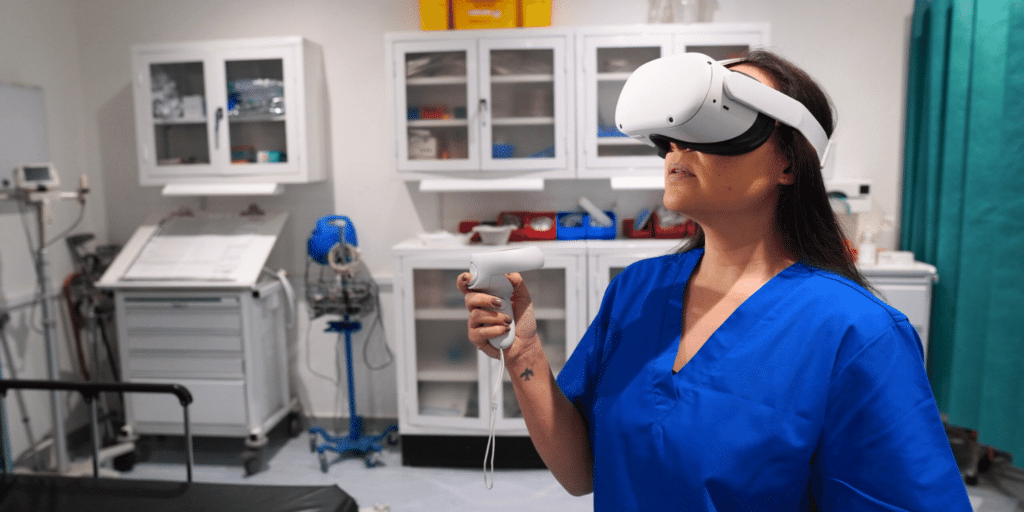As the new year kicks off, OMS is jumping right in and highlighting all the exciting new things available this year! Here’s a breakdown of what’s new at OMS in 2023:
- Competency Mapping & Tracking
- Multi-patient scenarios
- Voice control
- Hand interaction
- OMS Create (authoring platform)
1. Competency Mapping & Tracking
Simulation is great for improving clinical competencies, but it can be a challenge to find virtual reality simulations that track progress in a way that aligns with current competency frameworks.
As a way to supercharge your insights, OMS created Competency Mapping and Tracking, which is now part of OMS feedback and analytics. Available to all our clients since Fall 2022, this allows an administrator or faculty to toggle on the selected framework that reflects your curriculum and goals.
Once on, educators and learners alike can see progress as it relates to each area of practice in a given framework. With the ability to filter at the group or individual level, by date range, or by scenario, you can get a bird’s eye or granular view of how your cohort is progressing.
For example, if you wanted to see how your learners are advancing towards the NCLEX, you would be able to see data showing how often your learners are taking actions within a scenario that align with each core principle.
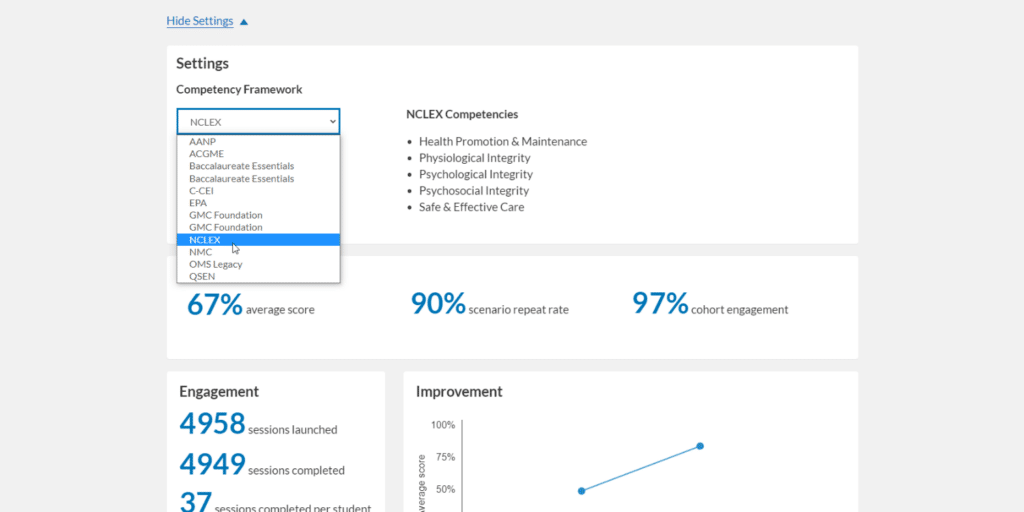
Health promotion and maintenance, physiological integrity, psychosocial integrity, and safe and effective care each have their own insights, meaning you can easily view where your learners are doing well and where there’s room for improvement.
In addition, individuals can get specific with the use of tags in their feedback section. These tags relate to each area of practice in a given framework, and they appear alongside pieces of evidence-based feedback, giving your learners a chance to gauge their progression towards each aspect of the competency framework.
Take a look at our webinar to see it in action!
2. Multi-patient scenarios
With a team composed of clinicians, simulationists and educators, OMS has a deep understanding of the skills required of healthcare professionals in any setting. Clinicians are often called upon to assess and intervene in emerging situations across multiple patients. This requires adept, in-the-moment clinical reasoning and decision making skills to recognize and act on dynamic changes in patient conditions.
That’s one reason why OMS partnered with the Big 10 Practice-Ready Nursing Initiative to develop scenarios that reflect the reality of managing multiple patients at one time. These simulations require skills like multitasking, delegating, and reprioritizing to provide optimal patient care.
Over the course of five simulations, learners can increase their caseload from one up to five patients. While some patients will require direct care, others will need to be managed by other means (e.g. over the phone), challenging learners’ clinical reasoning, decision making, and time management skills. Students and practitioners alike can work on clinical competence, care prioritization, and patient and interprofessional communication.
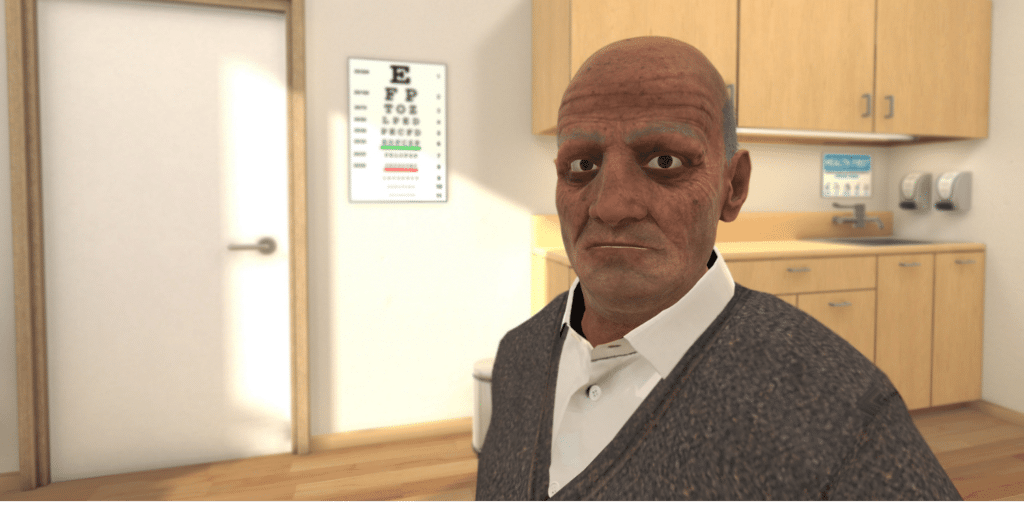
Available to the Big 10 now, these simulations are available for wider release from April 2023.
Backed by a grant from the American Nurses Foundation, the initiative to develop multi-patient scenarios was formed to address concerns over preparedness of nursing graduates for today’s healthcare environments, to improve time-to-onboard at new facilities, and to reduce likelihood of burnout and nursing turnover.
3. Voice control
Communication skills in healthcare are vital to actively listening to patients and providing quality care.
In 2022, OMS began to address the need for authentic practice of communication skills by introducing the use of voice control into VR simulations, allowing learners to speak and interact with virtual patients just like in real life.
In scenarios with a primary focus on communication skills, learners can complete a thorough patient interview – from presenting issue to social situation and everything in between – as well as provide patient education and reassurance.
Through the use of AI, machine learning and natural language processing, what the patient says and how they respond depends on what’s been said already, or how a question has been asked – just as you’d expect when having a conversation in the clinic.
These virtual patients learn over time, meaning they get better at understanding what’s being asked of them – that is to say, as your communication skills improve, so should the understanding of your patient!
Still to come in 2023, certain scenarios will have a more directed focus on the technical elements of delivering information effectively in the clinic. These simulations include skills like rapport-building, information gathering, and shift-to-shift handover reporting.
Additional scenarios will require learners to convey empathy while talking with patients, particularly when delivering bad news, practicing motivational interviewing, or when de-escalating an evolving situation.
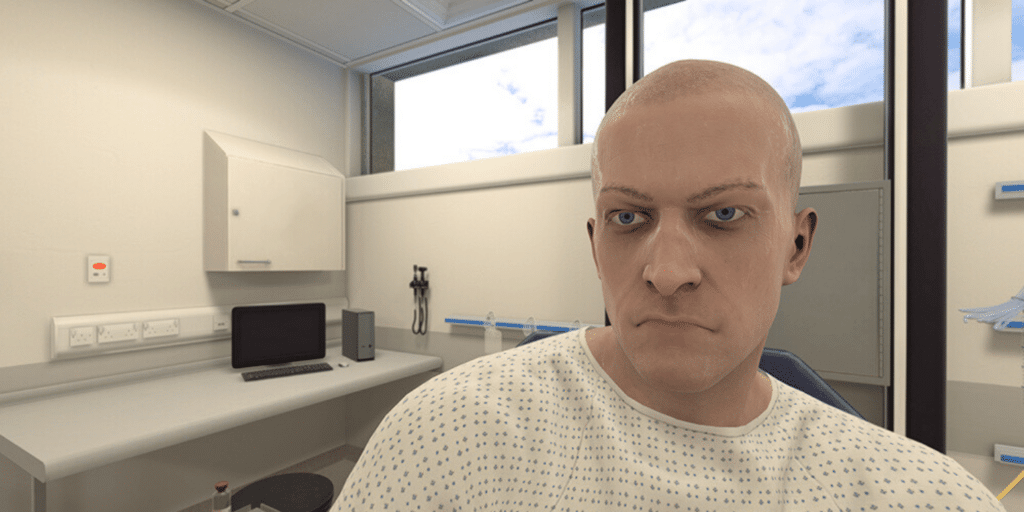
In 2023, voice control is being scaled across the OMS platform and will be used in a wide range of scenarios, adding another layer of immersion and complexity to simulations.
As more and more scenarios incorporate the use of voice control to reflect holistic patient care, learners will need to gather and relay important information while they complete scenarios encompassing a wide array of clinical skills.
Building communication skills goes beyond one area of healthcare. As it is the responsibility of all healthcare professionals to communicate effectively with other providers, patients, and families, these scenarios can be utilized by allied health professionals, nurses, and physicians alike.
4. Hand interaction
Just like practicing speaking with others in the clinic is important for strengthening communication skills, building muscle memory is a vital part of training for effective and efficient procedural skills.
That’s why OMS has implemented the use of hand interaction in procedural scenarios, allowing learners to repeatedly move through the steps of a procedure using their hands in real time.
The actions you take determine what you feel. For example, if you grab a urinary catheter, physics-driven systems make it bend and flex just like in real life, and when you insert it vibrotactile elements provide immediate haptic feedback on progress.
Hand interaction scenarios are available now, with ongoing procedural skills over 2023 including urinary catheterization, PIVC insertion, wound care, CVC care and more…
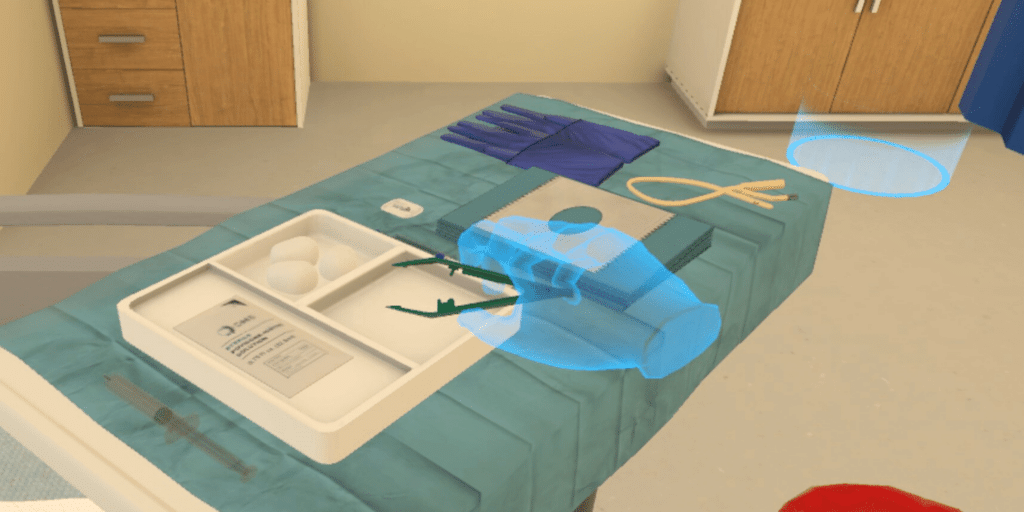
Over time, hand interaction will be built into existing non-procedural OMS scenarios, creating a more fluid and immersive environment for your learners to navigate.
The use of voice control and hand interaction is one part of putting it all together, so that you have the ability to call upon whichever interaction type best fits your learning objectives – allowing your learners to safely build confidence, competence, and effectively manage the complexities of the clinic.
5. OMS Create
VR simulations are not one-size-fits-all, and OMS Create is a new authoring platform that allows you to have more control over the situations your learners will face in scenarios.
Built for educators, simulationists and simtechs, OMS Create is a no-code platform, allowing you to navigate it and customize as you see fit without the need for a developer or any coding knowledge.
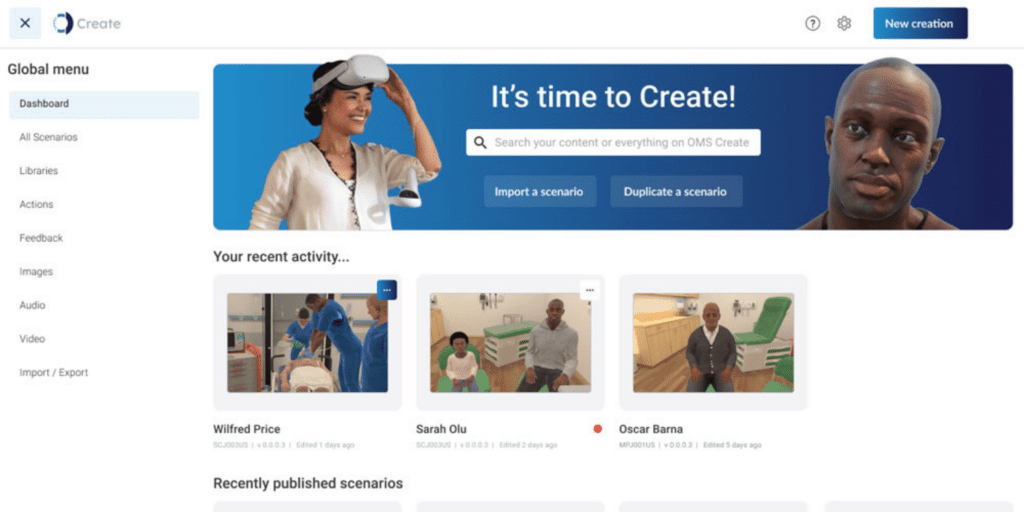
OMS Create has the same power that internal authors at OMS use to create scenarios, meaning you’ll have the freedom to build and adapt scenarios just like our authors do. Want to switch environments? Need a specific patient response? Want to change a patient’s skin integrity?
What if you just want to tweak some settings, adjust vital signs, change labs, rename medications, or switch out imaging? All is possible with OMS Create!
This flexibility allows you to easily determine the difficulty of a scenario to challenge the learner at their level and to integrate scenarios into your curriculum to align with competency-based standards.
With OMS Create, you can easily build your own scenario from scratch or customize an existing one – it’s all up to you to decide!
There’s so much ahead, not just for OMS but for the use of virtual reality in healthcare education and training in general, and we’re excited to be driving it forward.
Ready for a demonstration? Get in touch and we’re happy to walk you through OMS and discuss where VR simulations may fit into your goals.
